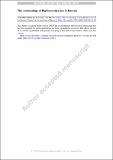| dc.contributor.author | Price, Max D | |
| dc.contributor.author | Hongo, Hitomi | |
| dc.date.accessioned | 2020-11-18T21:14:10Z | |
| dc.date.available | 2020-11-18T21:14:10Z | |
| dc.date.issued | 2019-12 | |
| dc.identifier.issn | 1059-0161 | |
| dc.identifier.issn | 1573-7756 | |
| dc.identifier.uri | https://hdl.handle.net/1721.1/128524 | |
| dc.description.abstract | The multifaceted behavioral and ecological flexibility of pigs and wild boar (Sus scrofa) makes study of their domestication both complex and of broad anthropological significance. While recognizing contextual contingency, we propose several “pathways” to pig domestication. We also highlight the diversity of pig management practices. This diversity complicates zooarchaeological detection of management techniques employed by humans in the early steps of domestication, and we stress the need for multiple lines of evidence. Drawing together the evidence, we review early Holocene human–Sus relations in Japan, Cyprus, northern Mesopotamia, and China. Independent pig domestication occurred in northern Mesopotamia by c. 7500 cal. BC and China by c. 6000 cal. BC. In northern Mesopotamia pig domestication followed a combined “commensal and prey” pathway that evolved into loose “extensive” husbandry that persisted as the dominant form of pig management for several millennia. There are not yet enough zooarchaeological data to speculate on the early stages of pig domestication in China, but once that process began, it involved more intensive management (relying on pens and fodder), leading to more rapid selection for phenotypes associated with domestication. Finally, pig domestication “failed” to take off in Japan. We suggest this was related to a number of factors including the lack of domestic crops and, potentially, cultural barriers to conceiving animals as property. | en_US |
| dc.publisher | Springer Science and Business Media LLC | en_US |
| dc.relation.isversionof | https://doi.org/10.1007/s10814-019-09142-9 | en_US |
| dc.rights | Article is made available in accordance with the publisher's policy and may be subject to US copyright law. Please refer to the publisher's site for terms of use. | en_US |
| dc.source | Springer US | en_US |
| dc.title | The Archaeology of Pig Domestication in Eurasia | en_US |
| dc.type | Article | en_US |
| dc.identifier.citation | Price, Max and Hitomi Hongo. "The Archaeology of Pig Domestication in Eurasia." Journal of Archaeological Research 28, 4 (December 2019): 557–615 © 2019 Springer Science Business Media, LLC | en_US |
| dc.contributor.department | Massachusetts Institute of Technology. Department of Materials Science and Engineering | en_US |
| dc.relation.journal | Journal of Archaeological Research | en_US |
| dc.eprint.version | Author's final manuscript | en_US |
| dc.type.uri | http://purl.org/eprint/type/JournalArticle | en_US |
| eprint.status | http://purl.org/eprint/status/PeerReviewed | en_US |
| dc.date.updated | 2020-09-24T21:37:27Z | |
| dc.language.rfc3066 | en | |
| dc.rights.holder | Springer Science+Business Media, LLC, part of Springer Nature | |
| dspace.embargo.terms | Y | |
| dspace.date.submission | 2020-09-24T21:37:27Z | |
| mit.journal.volume | 28 | en_US |
| mit.journal.issue | 4 | en_US |
| mit.license | PUBLISHER_POLICY | |
| mit.metadata.status | Complete | |
